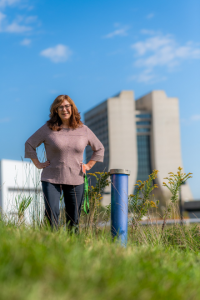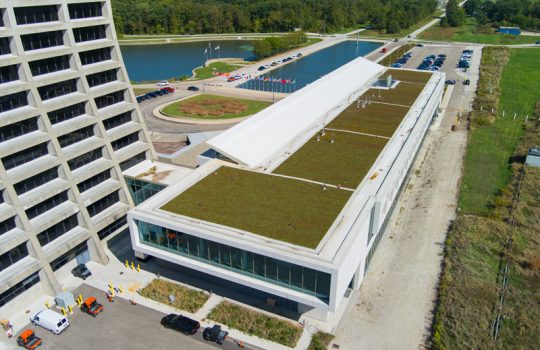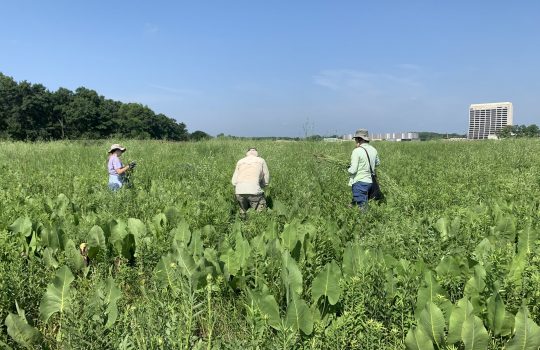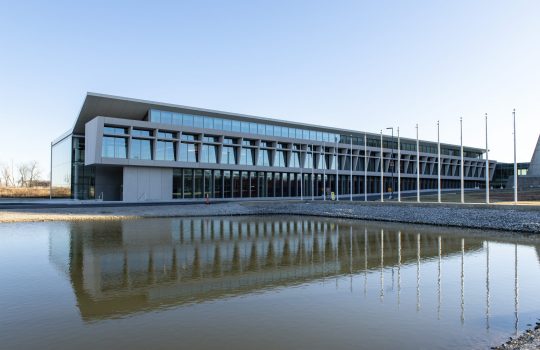
Environmental program manager Lori Huntoon, ready to check an environmental monitoring well at Fermilab that her team uses to collect water-level measurements. Photo: Dan Svoboda, Fermilab
What is your new role at the U.S. Department of Energy’s Fermi National Accelerator Laboratory?
I’m the environmental program manager, and I’ve been here for three months. It’s really great. I feel so fortunate to be part of such a cohesive team who are learning from each other and supporting one another and have a lot of energy. My whole career has kind of culminated in this position — and it’s so exciting to be here.
How has your career led you to this position at Fermilab?
I’m a geologist and have spent most of my career in environmental consulting. I also worked with the state of Wisconsin as chief of the Petroleum Cleanup Fund, so I have experience as a regulator and got to see things from that compliance perspective. For my “midlife crisis,” I left the field, and I became a secondary science and English-as-a-second language teacher.
My father was a drilling engineer and managed water projects around the world, so groundwater protection and environmental compliance have been a focus throughout my life. I went back into consulting and had my own firm for a few years, representing municipalities and providing expert witness services for law firms. I started working for DOE projects back in 2018.
I took a tour of Fermilab in 2016, and I decided at that time that this is where I wanted to culminate my career, by working at Fermilab. I love the fact that it’s focused on research and discovery. I love that there are so many dynamic people who are exploring the universe and all the complex problems related to energy and dark matter. The physics part of Fermilab just geeks me out every day.
As the environmental program manager, what are your goals for this program?
My goal in the next few years is to integrate environmental management into every system. We cover a lot of aspects related to the environment, everything from air emissions, cultural resource management, the National Environmental Policy Act, groundwater, permits for water going into the City of Batavia wastewater treatment system, and hazardous waste. There are a lot of decisions that we have to make on site, and we are involved in making sure that Fermilab remains compliant with all of these.
One of my goals is to have people realize that the environmental program is here, not just to focus on compliance, but to be a part of the team that ensures the Fermilab mission continues in the most efficient and effective way possible. We really want to build those systems in so they’re a part of everyone’s thought process — so that people think: ‘What are the environmental requirements here? Who do I call? Let’s get the environmental team in. Let’s ask them questions.’ We want environmental management to be an integral part of everyone’s job, not a just second thought.
What projects are you working on right now?
We have a lot of projects going on, but right now I’d say we’re working on two big focuses.
We conduct an internal Environmental Management System assessment where we evaluate the EMS every three years. What we do is conduct interviews and review documentation. This EMS assessment will help us determine how we can enhance our system and how we can better communicate it to everyone in the laboratory. We’ve been able to expand our environmental department significantly, and with that we have tremendous opportunities to spend time building working relationships and training others. It’s really an exciting time for me to be here because I like that challenge!
Another issue we’re working on is an emerging contaminant called PFAS: per- and poly-fluoroalkyl substances. PFAS is ubiquitous; it’s everywhere. For example, it is in non-stick pans, fire extinguishers, sticky notes and other household items. It has a fluorine-carbon bond that is very difficult to destroy, and to dispose of it is incredibly costly.
DOE has an action plan, and part of it is to minimize use of PFAS substances on site, but there are areas where projects require its continued use. We are preparing best management practices to put into place. We’re determining where we could provide training and more explanation of what makes a PFAS substance different than anything else and how it needs to be handled a little bit differently.
What is the most challenging part of the work you are doing?
I’d say the most challenging part is that I want to understand everything that’s going on at Fermilab right now! I know it’s going to take years for me to understand the various aspects of this facility. Fortunately, the staff on the environmental team are great about anticipating and sharing the information I need to know.
What is the most rewarding part of your position?
The constant opportunity to geek out over the incredible science that we do here. That is by far the best. And also the endless camaraderie among everyone. I mean, everyone is just so available to help.
What do you do for fun outside of the lab?
I really like hiking and exploring, whether it’s in the city or in national parks.
My husband and I live on a farm in Wisconsin. So, I’m here during the week, and I go home on weekends. We have a small herd of llamas and goats, and they’re really fun.
Do you have any final words that you want people to know about your role?
I really want to help build a synergy throughout the laboratory. We’re here to work together to support the mission.
Fermi National Accelerator Laboratory is supported by the Office of Science of the U.S. Department of Energy. The Office of Science is the single largest supporter of basic research in the physical sciences in the United States and is working to address some of the most pressing challenges of our time. For more information, please visit science.energy.gov.



